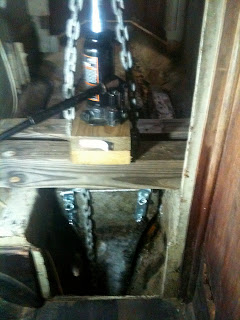 |
| Tensie Mae's cockpit well grating rigged for use as a table |
I have Talofa Lee about 80 percent ready for launch other than cosmetic work on the interior and exterior wood. I have completed a variety of large projects and will make a few posts later to highlight some of them.
Oh there's one more excuse - I haven't done much on her this winter because of other projects (including gutting and renovating a bathroom in our house).
This week I spent a few hours at the barn working on Talofa Lee to try to get back into a routine that will lead to finishing her. I decided to build the long-planned cockpit well grate to replace her original grate that was very worn and rickety while I consider my plan for doing the more important systems completion.
The grate is a well designed feature of the boat. It is made of teak and sits in the bottom of the well and provides good footing while allowing drainage through the grate into the cockpit well drains. If desired it can be moved to the top of the well to sit on rails and make the cockpit well flush with the seats so the cockpit can be used as a sleeping area. I also made a support for the grating on my other boat - Tensie Mae - so I can use the grate as a cockpit table (see the photo at the top of this entry).
As I said Talofa Lee's grate and well were in poor shape and needed a lot of TLC and a new grate.
 |
| Talofa Lee's cockpit well and rails for grate |
 |
| Talofa Lee's cockpit well grate |
The grate is a matrix of half-lap one inch square stock held in a picture frame of one and a quarter inch thick stock rabbeted to accept the matrix.
Then I cut and rabbeted and installed the frame then used a quarter inch roundover bit in my router to round the edges on the top; and used a microshave plane to take the corner off the bottom edge. A test fit on the rails in the cockpit well and inside the well confirmed that it was ready to go to work. I stood on it and it passed that test.
Talofa Lee's cockpit well grate
The matrix is screwed together at each half lap using 3/4 inch long flat head SS screws. I disassembled the old grate and used the hardware in the new grate. Only one screw was damaged in disassembly and I replaced that one.
I built the new grate out of Spanish cedar rather than teak. I used the cedar for two reasons- one is that I had never built a grate like this before and if I messed it up using the cedar would minimize my costs; and the second is that the cedar should weather and wear well enough and look good enough so I can use it for a few years and - since I would have the experience of having built one before - I could build one out of teak when the cedar became worn.
The best method for preparing the matrix is to cut all the dadoes for the half laps at once (or as limited by the width of your wood) then rip the matrix strips from the wider board. That's what I did using my table saw and a wobble dado blade. The dadoes are a half inch deep. The open areas are an inch and a half wide. The strips are one inch wide.
 |
| Spanish cedar board dadoed and ready for ripping |
After the strips are ripped it's pretty simple to put the matrix together. I had to do some sanding of the completed matrix because my dado depth was just a little bit too shallow.
 |
| Assembled grate matrix |
After assembly I trimmed the edges straight and measured to get the width of the picture frame surround.
 |
| Completed cockpit well grate |
Then I cut and rabbeted and installed the frame then used a quarter inch roundover bit in my router to round the edges on the top; and used a microshave plane to take the corner off the bottom edge. A test fit on the rails in the cockpit well and inside the well confirmed that it was ready to go to work. I stood on it and it passed that test.
Two coats of 50/50 varnish and mineral spirits have been applied. It is now waiting for completion of the rest of my projects and sea trials - in April???
I'm happy with the results.


























